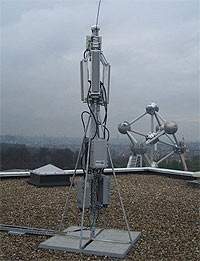Op theoretische gronden kan je al bedenken dat EM straling van een mobieltje geen kanker kan veroorzaken. Om kanker te krijgen zijn verschillende DNA beschadigingen in dezelfde cel nodig. EM straling van een mobieltje is niet energierijk genoeg om te ioniseren en kán dus geen schade aan DNA veroorzaken! Ergo EM straling veroorzaakt geen kanker.
Exogene oorzaken veroorzaakt door externe invloeden zoals
- verschillende vormen van straling, waaronder uv-straling en ioniserende straling (radioactiviteit, röntgenstraling, kosmische straling)
- een hitteschok, waardoor hydrolysereacties plaatsvinden in het DNA
- diverse chemische stoffen, waaronder cytostatica, diverse aromatische verbindingen en sommige plantentoxinen
De politici die deze wet er in België dorgedrukt hebben hebben blijkbaar geen verstand van goed wetenschappelijk onderzoek. Het onderzoek wat een zwakke link vond met mobiele telefoonie gebruik
en hersentumoren zat vol methodologische fouten:
http://www.ncbi.nlm.nih.gov/pubmed/22755267
Ook het onderzoek waaruit zou moeten blijketn dat EM straling een invloed zou hebben op de ontwikkeling/gedrag van kinderen is heel slecht van methodiek:
Several methodological limitations need to be taken into consideration when interpreting the findings of the epidemiological studies. The cross-sectional design does not allow determination of the temporal sequence of exposure and outcome, and for several outcomes there is a large potential for reversed causality, i.e. that the outcome causes an increased RF exposure rather than the opposite. Biases such as recall errors in self-reported mobile phone use, lack of confounding control, e.g. of other aspects of mobile phone use than RF fields, trained behaviors, and pubertal development, makes causal interpretations impossible.
Een sytematische review uit 2011 laat geen significante invloed zien.
http://www.ncbi.nlm.nih.gov/pubmed/22021071
Een hoop paniek om niks dus.
Dit is btw een stuk van de WHO wat hier bedoeld wordt
Are there any health effects?
A large number of studies have been performed over the last two decades to assess whether mobile phones pose a potential health risk. To date, no adverse health effects have been established as being caused by mobile phone use.
Short-term effects
Tissue heating is the principal mechanism of interaction between radiofrequency energy and the human body. At the frequencies used by mobile phones, most of the energy is absorbed by the skin and other superficial tissues, resulting in negligible temperature rise in the brain or any other organs of the body.
A number of studies have investigated the effects of radiofrequency fields on brain electrical activity, cognitive function, sleep, heart rate and blood pressure in volunteers. To date, research does not suggest any consistent evidence of adverse health effects from exposure to radiofrequency fields at levels below those that cause tissue heating. Further, research has not been able to provide support for a causal relationship between exposure to electromagnetic fields and self-reported symptoms, or “electromagnetic hypersensitivity”.
Long-term effects
Epidemiological research examining potential long-term risks from radiofrequency exposure has mostly looked for an association between brain tumours and mobile phone use.
Dit onderzoek was dus zoals we hierboven hebben gezien methodologisch zeer slecht.
However, because many cancers are not detectable until many years after the interactions that led to the tumour, and since mobile phones were not widely used until the early 1990s, epidemiological studies at present can only assess those cancers that become evident within shorter time periods. However, results of animal studies consistently show no increased cancer risk for long-term exposure to radiofrequency fields.
Several large multinational epidemiological studies have been completed or are ongoing, including case-control studies and prospective cohort studies examining a number of health endpoints in adults. The largest retrospective case-control study to date on adults, Interphone, coordinated by the International Agency for Research on Cancer (IARC), was designed to determine whether there are links between use of mobile phones and head and neck cancers in adults. The international pooled analysis of data gathered from 13 participating countries found no increased risk of glioma or meningioma with mobile phone use of more than 10 years. There are some indications of an increased risk of glioma for those who reported the highest 10% of cumulative hours of cell phone use, although there was no consistent trend of increasing risk with greater duration of use. The researchers concluded that biases and errors limit the strength of these conclusions and prevent a causal interpretation. Based largely on these data, IARC has classified radiofrequency electromagnetic fields as possibly carcinogenic to humans (Group 2B), a category used when a causal association is considered credible, but when chance, bias or confounding cannot be ruled out with reasonable confidence.
Oftwel een zwakke better safe than sorry positie, gebaseerd op onderzoeks resultaten met een slechte opzet.
While an increased risk of brain tumors is not established, the increasing use of mobile phones and the lack of data for mobile phone use over time periods longer than 15 years warrant further research of mobile phone use and brain cancer risk. In particular, with the recent popularity of mobile phone use among younger people, and therefore a potentially longer lifetime of exposure, WHO has promoted further research on this group. Several studies investigating potential health effects in children and adolescents are underway.
[Reactie gewijzigd door switchboy op 8 augustus 2024 14:08]
 De wetgeving, die al is goedgekeurd door het Belgische parlement en over een halfjaar van kracht wordt, geldt zowel voor webwinkels als fysieke winkels. Winkeliers die zich niet aan de nieuwe wet houden, kunnen een boete krijgen.
De wetgeving, die al is goedgekeurd door het Belgische parlement en over een halfjaar van kracht wordt, geldt zowel voor webwinkels als fysieke winkels. Winkeliers die zich niet aan de nieuwe wet houden, kunnen een boete krijgen.
:strip_exif()/i/1106305409.gif?f=fpa)
/i/1357300660.png?f=fpa)
/i/1241509515.png?f=fpa)
/i/1244639855.png?f=fpa)
/i/1211356613.png?f=fpa)